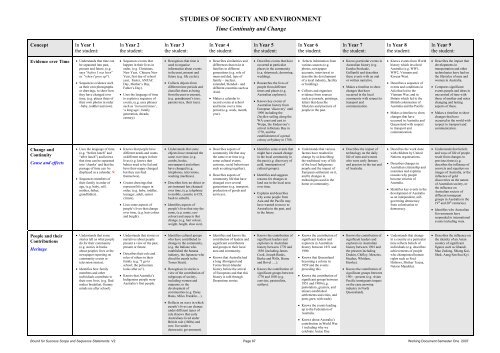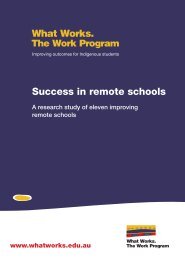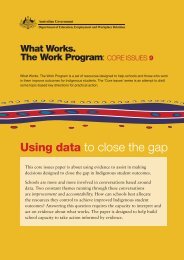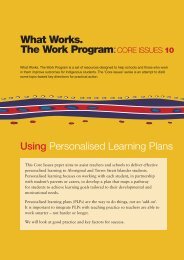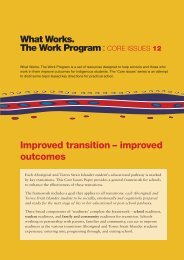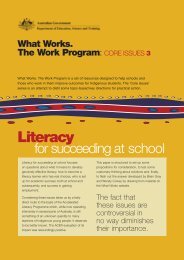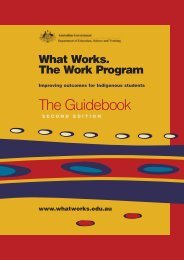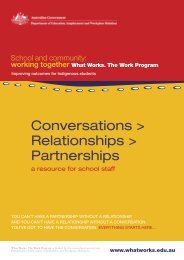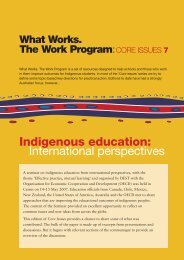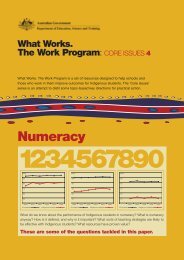Bound for Success Scope and Sequence Statements
Bound for Success Scope and Sequence Statements
Bound for Success Scope and Sequence Statements
- No tags were found...
You also want an ePaper? Increase the reach of your titles
YUMPU automatically turns print PDFs into web optimized ePapers that Google loves.
STUDIES OF SOCIETY AND ENVIRONMENTTime Continuity <strong>and</strong> ChangeConcept In Year 1the student:In Year 2the student:In Year 3the student:In Year 4the student:In Year 5the student:In Year 6the student:In Year 7the student:In Year 8the student:In Year 9the student:Evidence over Time• Underst<strong>and</strong>s that time canbe separated into past,present <strong>and</strong> future, (e.g.says “be<strong>for</strong>e I was born”or “when I grow up”).• <strong>Sequence</strong>s evidence suchas their own photographsor drawings, to show howthey have changed overtime, (e.g. places three oftheir own photos in order–baby, toddler <strong>and</strong> now).• <strong>Sequence</strong>s events thathappen in their lives inorder, (e.g. Christmas,New Year, Chinese NewYear, first day of schoolyear, Easter, ANZACDay, Mother’s Day,Father’s Day).• Uses the language of timeto explain a sequence ofevents, (e.g. uses phrasessuch as ‘in recent times’,‘a long ago’, familygeneration, decade,century).• Recognises that time isused to organisein<strong>for</strong>mation about eventsin the past, present <strong>and</strong>future (e.g. life cycles).• Collects objects fromdifferent time periods <strong>and</strong>classifies them as beingfrom the past or present,(e.g. gr<strong>and</strong>parent’s toys,parents toys, their toys).• Describes similarities <strong>and</strong>differences that exist infamilies in differentgenerations (e.g. role ofmum <strong>and</strong> dad, type offamily – nuclear,extended, blended - <strong>and</strong>different countries such asAsia).• Makes a calendar torecord events at school<strong>and</strong> home over a timeperiod (e.g. week, month,year).• Describes events that haveoccurred at particularplaces in the community(e.g. shipwreck, drowning,wedding).• Researches the lives ofpeople from differenttimes <strong>and</strong> places (e.g.Australian explorers).• Knows key events ofAustralian history fromEuropean ‘discovery’ until1900 including theDuyfken sailing along theWA coast <strong>and</strong> east toWeipa, the Endeavour’sarrival in Botany Bay in1770, <strong>and</strong> theestablishment of a penalcolony at Sydney in 1788.• Selects in<strong>for</strong>mation fromvarious sources (e.g.photos, newspaperaccounts, interviews) todescribe the developmentof a local industry, facilityor building).• Collects <strong>and</strong> organisesevidence from sourcessuch as journals, paintings,letters that describelifestyles <strong>and</strong> practices ofpeople in the past.• Knows particular events inAustralian history (e.g.Eureka Stockade,Gallipoli) <strong>and</strong> describesthese events with an oralor written narrative.• Makes a timeline to showchanges that haveoccurred in the localcommunity with respect totransport <strong>and</strong>communication.• Knows events from Worldhistory which involvedAustralia (e.g. WW1,WW2, Vietnam <strong>and</strong>Korean War).• Describes a sequence ofevents <strong>and</strong> conditions inAsia that led to theVietnam War, <strong>and</strong> inBritain which led to theBritish colonisation ofAustralia <strong>and</strong> the Pacific.• Makes a timeline to showchanges that haveoccurred in Australia <strong>and</strong>Queensl<strong>and</strong> with respectto transport <strong>and</strong>communication.• Describes the impact thatdevelopments intransportation <strong>and</strong> othertechnologies have had onthe lifestyles of men <strong>and</strong>women in Australia.• Compares significantevents people <strong>and</strong> ideas inone period of time withthose of another <strong>and</strong> noteschanging <strong>and</strong> lastingaspects of these.• Makes a timeline to showchanges that haveoccurred in the world withrespect to transport <strong>and</strong>communication.Change <strong>and</strong>ContinuityCause <strong>and</strong> effects• Uses the language of time,(e.g. “be<strong>for</strong>e lunch” <strong>and</strong>“after lunch”) <strong>and</strong> knowsthat time can be separatedinto ‘chunks’ <strong>and</strong> that thepassage of time can bedisplayed as a calendar. N• <strong>Sequence</strong>s members oftheir family in order ofage, (e.g. baby, self,mother, father,gr<strong>and</strong>father).• Knows that people havedifferent needs <strong>and</strong> wantsat different stages in theirlives (e.g. knows thatbabies need to be fed <strong>and</strong>have their nappy changedbut they can feedthemselves).• Creates drawings thatrepresent life stages inorder, (e.g. baby, toddler,teenager, adult, seniorcitizen).• Lists some aspects ofpeople’s lives that changeover time, (e.g. hair colour<strong>and</strong> height).• Underst<strong>and</strong>s that someobjects have remained thesame over time, (e.g.combs, books,newspapers) <strong>and</strong> othershave changed (e.g.telephones, televisions,washing machines).• Describes how an object orenvironment has changedover time, (e.g. telephoneto mobile, cassette to CD,bush to suburb).• Identifies aspects ofpeople’s lives that stay thesame, (e.g. name, eyecolour)<strong>and</strong> aspects thatchange, (e.g. hair colour,weight, height, shoe size).• Describes aspects ofcommunity life that staythe same over time (e.g.some cultural events,customs, social behaviourssuch as eating together).• Describes aspects ofcommunity life that havechanged over severalgenerations (e.g. transport,production of goods <strong>and</strong>services).• Identifies some events thatmight have caused changein the local community inthe past (e.g. discovery ofgold, immigration ofcultural groups).• Identifies <strong>and</strong> suggestsreasons <strong>for</strong> changes inl<strong>and</strong> use in the local areaover time.• Explains <strong>and</strong> describeswhy some people fromAsia <strong>and</strong> the Pacific mayhave wanted to move toAustralia in the past, <strong>and</strong>in the future.• Underst<strong>and</strong>s that variousfactors have resulted inchange by a) describingthe traditional way of lifeof the local Indigenouspeople <strong>and</strong> the impact ofEuropean settlement on it,<strong>and</strong> b) changes intechnologies used in thehome or community.• Describes the impact oftechnology on the dailylife of men <strong>and</strong> womenwho were early farmers<strong>and</strong> graziers in the top endof Australia.• Describes the work donewith children by UnitedNations organisations.• Describes changes inAustralian citizenship <strong>and</strong>examines <strong>and</strong> explainsreasons why peoplebecome citizens ofAustralia.• Identifies key events in thedevelopment of Australiaas an independent, selfgoverningdemocracyfrom colonisation todemocracy.• Underst<strong>and</strong>s that beliefs<strong>and</strong> ways of life of peopleresult from changes inprevious times (e.g.describes the influence ofconvicts <strong>and</strong> squatters onimages of Australia, or theinfluence of golddiscoveries on the natureof Australian society, orthe influence onAustralian society ofdifferent immigrantgroups in Australia in the19 th <strong>and</strong> 20 th centuries).• Identifies why AustralianGovernments haveresponded to internationalevents including wars.People <strong>and</strong> theirContributionsHeritage• Underst<strong>and</strong>s that somestories tell us what peopledo <strong>for</strong> their community(e.g. stories in booksabout peoples lives or thenewspaper reporting oncommunity events ortelevision stories).• Identifies how familymembers <strong>and</strong> otherindividuals contribute totheir own lives, (e.g. Dadmakes breakfast, Grannyminds me after school).• Underst<strong>and</strong>s that stories ornarratives about peoplepresent a view of the past,present or future.• Describes their role <strong>and</strong>roles of others in theirfamily (e.g. “I go toschool; the policemanlooks after us”).• Knows that Australia’sIndigenous people wereAustralia’s first people.• Identifies cultural groupswho have contributed tochange in the community,(e.g. the Italians whoestablished the bananaindustry, the Japanese whodived <strong>for</strong> pearls in theTorres Strait).• Recognises in stories aview of the contribution ofsubgroups of society,including women <strong>and</strong>migrants, to thedevelopment ofcommunities (e.g. DaisyBates, Miles Franklin…).• Reflects on ways in whichpeople’s lives can changeunder different types ofrule (knows that earlyAustralians lived underBritish rule (1800s) <strong>and</strong>now live under ademocratic government).• Identifies <strong>and</strong> knows thecontribution of leaders <strong>and</strong>significant contributors<strong>and</strong> groups in their localarea <strong>and</strong> community.• Knows that Australia hada long Aboriginal <strong>and</strong>Torres Strait Isl<strong>and</strong>erhistory be<strong>for</strong>e the arrivalof Europeans <strong>and</strong> that thishistory is told throughDreamtime stories.• Knows the contribution ofsignificant leaders <strong>and</strong>explorers in Australianhistory between 1770 <strong>and</strong>1850 (including JamesCook, Joseph Banks,Burke <strong>and</strong> Wills, Hume<strong>and</strong> Hovel ….).• Knows the contribution ofsignificant groups between1770 <strong>and</strong> 1850 (e.g.convicts, pastoralists,settlers).• Knows the contribution ofsignificant leaders <strong>and</strong>explorers in Australianhistory between 1851 <strong>and</strong>1900.• Knows that Queensl<strong>and</strong>becoming a colony in1859 <strong>and</strong> the eventspreceding this.• Knows the contribution ofsignificant groups between1851 <strong>and</strong> 1900 (e.g.pastoralists, graziers, <strong>and</strong>miners establishedsettlements <strong>and</strong> cities, <strong>and</strong>ports grew with trade)• Knows the events leadingup to the Federation ofAustralia.• Knows about Australia’scontribution in World War1 including why wecelebrate Anzac Day.• Knows the contribution ofsignificant leaders <strong>and</strong>explorers in Australianhistory between 1901 <strong>and</strong>the present (includingDeakin, Chifley, Menzies,Hughes, Whitlam,Hawke).• Knows the contribution ofsignificant groups between1901 - present (e.g. AsianPacific immigrants impacton the cane growingindustry in NorthQueensl<strong>and</strong>).• Underst<strong>and</strong>s that changein a country at a particulartime reflects beliefs ofindividuals (e.g. describesachievements of peoplewho championed humanrights such as FredHollows, Mother Teresa,Nelson M<strong>and</strong>ela).• Describes the influence onthe identity of an Asiancountry of significantfigures such as Gh<strong>and</strong>i,Mao Zedong, Shiang Kai-Shek, Aung San Suu Kyi.<strong>Bound</strong> <strong>for</strong> <strong>Success</strong> <strong>Scope</strong> <strong>and</strong> <strong>Sequence</strong> <strong>Statements</strong> V2 Page 67 Working Document Semester One 2007


